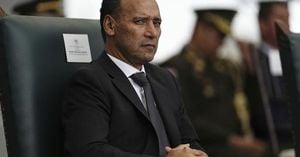As President Donald Trump’s motorcade wound its way to the Kennedy Center on August 13, 2025, the city’s streets were undergoing a dramatic transformation. Workers, flanked by city officials and federal agents, began clearing homeless encampments along the presidential route—a move that marked a new phase in Washington, D.C.’s ongoing struggle with homelessness. The crackdown, orchestrated by the Trump administration, has sent ripples of anxiety and confusion through the city’s more than 5,000 unhoused residents, raising urgent questions about safety, shelter, and the deeper roots of America’s housing crisis.
“I’m very concerned,” said George Morgan, a lifelong D.C. resident who had lived in an encampment for two months, as quoted by USA Today. Morgan, a Trump supporter, found himself caught in the sweep, uncertain of where he would go next. He refused to enter a shelter that wouldn’t allow him to keep his American pit bull terrier. “I try not to take offense,” he said, “but I’m hopeful God will make a way.” His predicament echoed the uncertainty faced by many others forced to uproot their lives overnight.
The administration’s approach has been swift and uncompromising. On August 12, White House spokeswoman Karoline Leavitt addressed reporters, making the administration’s stance clear: “Homeless people would be given the option to leave their encampment, to be taken to a homeless shelter, to be offered addiction or mental-health services, and if they refuse, they will be susceptible to fines or to jail time.” According to USA Today, at least two tents near the Kennedy Center were cleared on August 13, and notices were pinned to nine other tents warning residents that their camps would be dismantled if not removed by morning. The message was unmistakable—move now, or face legal consequences.
Federal agents have not just been clearing tents. They’ve also been visiting camps, asking residents if they have drugs or weapons, and reiterating the ultimatum: accept shelter or services, or risk fines and jail. As BBC reports, this intensified law enforcement push has reshaped daily life for many, bringing a wave of anxiety and confusion about what comes next. Since March, U.S. Park Police have removed 70 homeless encampments from federal parks, with plans to clear the last two in the city by mid-August.
For many advocates and policy experts, the crackdown is deeply troubling. “None of this is about anything to do with solving homelessness,” said Cameron Parsell, a professor at the University of Queensland, in comments to BBC. He pointed out that similar encampment clearances around the world—from Queensland, Australia, to Cardiff, Wales—have followed a familiar pattern: people are pushed into more hidden, less safe spaces, and their belongings are often discarded without recourse. The result, Parsell argues, is invisibility rather than resolution, with “huge human and societal consequences, all of which are negative.”
City officials say they’re trying to minimize disruption. Over the weekend before August 18, the Department of Human Services added about 70 beds to homeless shelters to accommodate an expected influx. Rachel Pierre, the agency’s acting director, acknowledged that shelters were at capacity when the order took effect, but said additional room could be made. Wayne Turnage, deputy mayor of the DC Department of Health and Human Services, emphasized the city’s goal: “Our objective is to see that the encampments are closed in an orderly fashion and to extend homeless services to those who are impacted. These people are human beings, they’re not chess pieces. Their lives are being disrupted, so we have to make sure that we do as much as we can to minimize the disruption.”
Yet, the numbers tell a sobering story. According to USA Today, the number of people living in encampments in D.C. has dropped from around 300 during the COVID-19 pandemic to about 100 as of August 18, 2025. However, a one-night survey in January counted 900 people living on the streets—a stark reminder that official counts may understate the scale of the crisis. And the roots of the problem run much deeper than tents on public land. The U.S. housing market was short 4.9 million units at the end of 2023, with affordable housing especially scarce. In Washington, D.C., approximately 12 percent of residents—about 82,452 people—are experiencing housing insecurity, most often due to unaffordability, according to BBC.
Advocates warn that policing and clearing encampments, without providing stable housing, is not a long-term solution. “The removal of our unhoused neighbors from public spaces without offering them stable housing first is not the solution,” said Adam Rocap of Miriam’s Kitchen, as quoted by BBC. Andrew Wassenich, director of policy at the same organization, added, “They’re not solving the homeless problem. It’s not going away. They’re just moving it.”
Globally, the pattern is consistent. In Moreton Bay, Australia, residents were given just an hour to move before bulldozers arrived. “We’re homeless already and you’re going to make us more homeless and then you’re going to fine us, how does that make sense?” one woman asked, as reported by BBC. The sense of futility and frustration is palpable, both in D.C. and abroad.
In response to the immediate crisis, more than 50 local and national groups have banded together to coordinate hotlines, open emergency beds in churches, and connect people with legal and housing support. Donald Whitehead of the National Coalition for the Homeless described these efforts as “a bridge” to get through the next 30 days, even if it’s not a permanent fix. Community-led responses are providing a lifeline for many, but advocates say real progress requires systemic change. They promote Housing First approaches, which prioritize permanent housing and wraparound services over punitive measures—a strategy backed by decades of research and championed by social service organizations nationwide.
For D.C. residents watching the drama unfold, the headlines can be overwhelming. Experts on political stress recommend setting boundaries on news consumption, engaging in respectful dialogue, and channeling concern into constructive action—volunteering, supporting eviction prevention programs, or advocating for affordable housing policies. As one mental health guide puts it, “Helping others is good for your mental health.”
The Trump administration’s crackdown has forced the city to confront uncomfortable truths about the limits of policing as a solution to homelessness. The crisis on D.C.’s streets is a stark reminder that the path to real safety and dignity runs through stable housing, not just cleared sidewalks. As encampments disappear from high-traffic areas, the underlying issues remain—waiting for solutions that reach beyond tents and temporary shelters.



